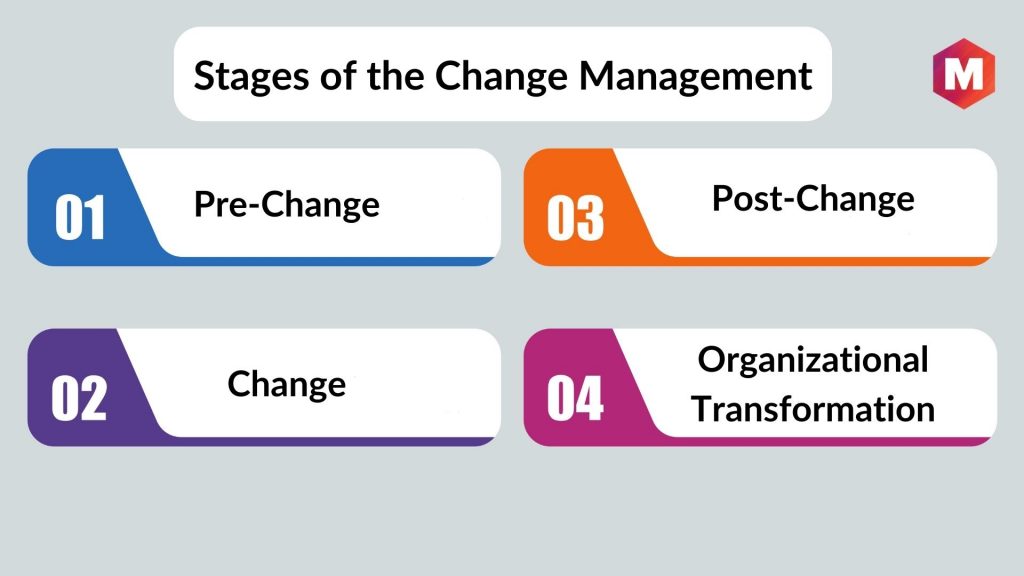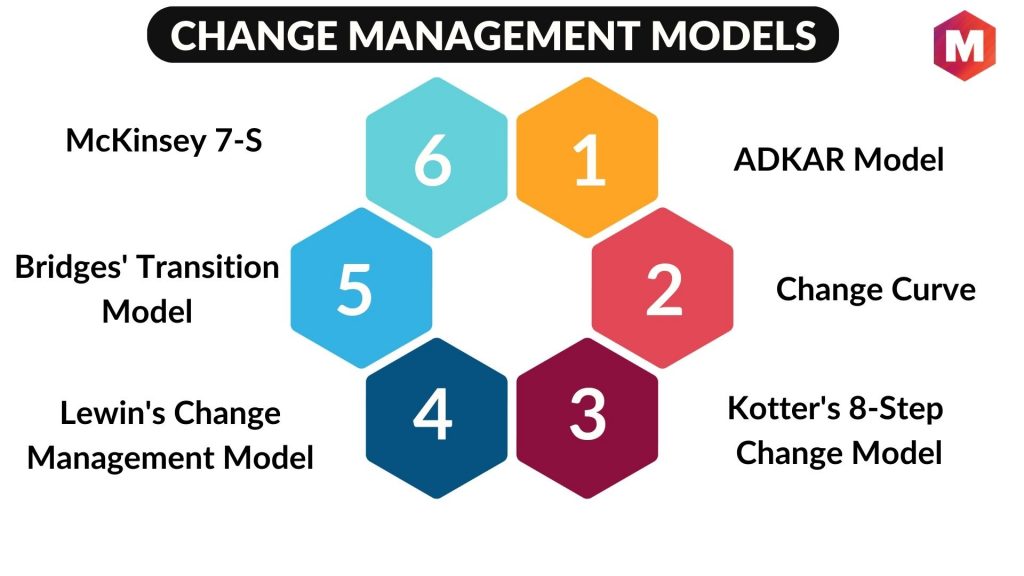Change management is the process of organizational change. Change management is the set of processes, tools, and techniques used to manage the people side of change. Change management is about how organizations deal with change.
An example of change management can be found in the way an organization deals with new technology. The introduction of a new system or software may require changes to existing processes and ways of working, which must be managed effectively if it is to succeed.
Change management is a method for managing the shift or transformation of an organization’s goals, procedures, or technologies. The goal of change management is to develop techniques for implementing change, controlling it, and assisting individuals in adapting to it.
Table of Contents
What is Change Management?
Change management is a structured approach to transitioning individuals, teams, and organizations from a current state to a desired future state. Change management is the process of supporting individuals and organizations through organizational changes.
Change management includes the tools and processes used to manage the people side of change. Change management is about how organizations deal with change. The purpose of change management is to ensure that changes are made in a controlled and coordinated manner, with minimum disruption to the organization, and that the benefits of the changes are realized.
Change management is a process, not an event. Change management is an ongoing process that starts when a change is first initiated and continues until the change is fully implemented and accepted. Change management is a journey, not a destination. Key roles of change leaders revolve around successfully implementing proposed changes regarding new technology, new corporate culture, a new change project, etc at an organizational level.
Steps of Change Management Process
There are four steps in a Change Management process
1. Understand Change
Change is a process, not an event. Change is an ongoing process that starts when a change is first initiated and continues until the change is fully implemented. You need to understand why you should change, how the change will happen, and what the impact of the change will be. Beckhard and Harris’ Change Equation is a good tool for understanding change.
2. Plan Change
Change does not happen by itself. Change happens as a result of planning and effort. For planning change, you may use tools like The Burke-Litwin Change Model, SIPOC Diagrams, Leavitt’s Diamond, etc. For planning during change management, you need to consider sponsorship, involvement, buy-in, and impact sorts of factors.
3. Implement Change
Kotter’s 8-Step Change Model and Lewin’s Change Model are two popular change management models for implementing change. When implementing a change, you should apply a sense of urgency to your actions so that you have momentum and encourage everyone to back your changes.
You should also ensure that everyone involved in change understands what is supposed to happen and how that will be valuable for them. Also, have success criteria for your changes. Try to find ways to change people’s habits so the changed practice becomes a norm.
4. Communicate Change
Communication is a key aspect of change management. The initiative you’re proposing must be crystal clear and relevant in order for others to grasp what you want them to do and why they need to do it. However, you also have to establish the proper tone so that you elicit the emotional response you desire. The ADKAR (Awareness, Desire, Knowledge, Ability, Reinforcement) Change Model is a popular tool for communicating change.
How Change Management Process Works?
To better comprehend the workings of change management, it is useful to implement its principles and techniques in particular business niches. Change management involves the recognition and assessment of change, planning for the implementation of change, executing the changes in an effective manner, monitoring its progress, and making necessary adjustments to ensure successful outcomes. The process is designed to minimize resistance and maximize acceptance of a certain change so that it will be implemented with success. Let’s understand how it works in different areas –
Change Management for Project Management
Project management is the process of planning, executing, and monitoring a project to ensure that it is completed on time and within budget. Change management is a process that helps to ensure that changes are made in a controlled and coordinated manner.
Change management for project management helps to ensure that changes to projects are made in a way that minimizes disruption and maximizes opportunities for success.
When implementing change management for project management, a few project areas that change control experts should pay particular attention to are-
- How the change will affect the project scope
- How the change will affect the project schedule
- How the change will affect project costs
- How the change will affect the quality of the product
- Need for additional human resources
- Communicating approved change requests to the appropriate stakeholders at the appropriate time
- What risks the change requests may impose
- How changes to the project may affect the procurement of materials as well as contract labor
Your change program will achieve success when you manage change and do the successful implementation of project change management steps to get favorable project outcomes.
Change management for software development
Software development is the process of creating, testing and deploying software applications. Change management for software development helps to ensure that changes to software applications are made in a controlled and coordinated manner.
Software development change management entails ensuring that software modifications are carried out in a way that minimizes disruption and maximizes benefits.
Change management techniques and tools are used in software development project management to help developers manage code changes as well as documentation and enable CIOs to keep projects on track.
Agile software development environments, as the name implies, encourage modifications to meet needs and/or modify the user interface. Change is not addressed in the middle of an iteration; instead, changes are planned for future iterations as stories or features.
Change management for IT infrastructure
The process of planning, building, and maintaining an organization’s IT infrastructure. Change management for IT infrastructure helps to ensure that changes to IT infrastructure are made in a controlled and coordinated manner.
Change management tools are also used to keep track of modifications made to the information technology department’s hardware infrastructure. Standardized approaches and procedures ensure that every change to the infrastructure is assessed, authorized, recorded, put into action, and reviewed in a systematic manner, as with other forms of change management.
Importance of Managing Change
There are many reasons why managing change is important. Change is inevitable, and it is happening all around us all the time. Change can be positive or negative, planned or unplanned, small or large. Change can be disruptive and challenging, but it can also be an opportunity for growth and development.
Change can be difficult to manage, but if it is managed effectively, it can lead to positive outcomes. Change management helps organizations to anticipate and prepare for changes, to minimize the negative impact of disruptions, and to maximize the opportunities that change presents.
Benefits of Change Management
Change management is critical to the success of any software development project. Change management helps to ensure that changes are made in a controlled and coordinated manner. Change management tools are used to keep track of modifications made to the code, documentation, and user interface.
Some of the benefits are
- Improved communication
- Enhanced team productivity
- Reduced risk
- Increased clarity around roles and responsibilities
- Greater buy-in from employees and other key stakeholders
- Improved customer satisfaction
- Helps organizations to achieve their goals
- Helps organizations adapt to changes in the environment
- Helps organizations to survive and thrive in a changing world
- Helps individuals to cope with change
- Helps individuals to adapt to change
- Helps individuals to thrive in a changing world
Stages of the Change Management
There are four stages in change management processes:
1. Pre-change
This is the stage where changes are first initiated. Change initiatives are often met with resistance at this stage. Change management helps to overcome this resistance and ensure that changes are made in a controlled and coordinated manner.
2. Change
This is the stage where changes are implemented. Change management helps to ensure that changes are made in a way that minimizes disruption and maximizes opportunities for success.
3. Post-change
This is the stage where changes are accepted and assimilated into the organization. Change management helps to ensure that changes are fully integrated and that the benefits of the changes are realized.
4. Organizational transformation
This is the stage where an organization undergoes a complete transformation as a result of change. Change management helps to ensure that organizational transformations are managed effectively so that the organization can emerge
Change Management Principles
1. Unfreeze the current state
In order to change, organizations must first “unfreeze” the current state. Change requires that people let go of old ways of doing things and adopt new ways. Change is often resisted because it requires people to let go of the past and embrace the future. Change management helps organizations to overcome this resistance and to “unfreeze” the current state.
2. Change the state
Change is a process of moving from the current state to the desired state. Change management helps organizations identify the desired state, to develop a plan for how to get there, and to implement the change.
3. Refreeze
Once the desired state is reached, it is important to “refreeze” the new state. Change management helps organizations consolidate the gains from the change and ensure that the new state is sustainable. Change management is an ongoing process that starts when a change is first initiated and continues until the change is fully implemented and accepted. Change management is a journey, not a destination.
Types of organizational change
Different types of organizational change efforts revolve around
- Development change: Change that is focused on improving the organization’s ability to develop new products or services.
- Transitional change: Change that is focused on moving the organization from one state to another, such as from the startup to the growth phase.
- Transformational change: Change that is focused on fundamental changes to the way the organization does business.
Popular Models, You Can Use to Manage Change
Some of the leading change management models that project managers can use to handle their change projects and accomplish their project objectives are-
1. ADKAR model
A model for individual change that is focused on Awareness, Desire, Knowledge, Ability, and Reinforcement.
2. Change curve
A model that describes the stages of grief that people go through when they experience change.
3. Kotter’s 8-step change model
A model for organizational change that is focused on creating a sense of urgency, forming a guiding coalition, creating a vision, communicating the vision, empowering employees to act on the vision, planning for and creating short-term wins, consolidating gains, and producing more change, and anchoring new approaches in the culture.
4. Lewin’s Change Management Model
A three-step model for organizational change that is focused on unfreezing, changing, and refreezing.
5. Bridges’ Transition Model
A model for understanding and managing reactions to change that is focused on the stages of ending, letting go, the neutral zone, and the new beginning.
6. McKinsey 7-S
A model for organizational change that is focused on Strategy, Structure, Systems, Style, Staff, Shared values, and Skills.
Change Management Challenges
A few challenges to change management strategy are-
- Lack of communication
- Lack of buy-in
- Lack of understanding of roles and responsibilities
- Resistance to change
Here is a video by Marketing91 on Change Management.
Overcoming Resistance to Change
There are a few ways to overcome resistance to change
- Open communication: Change is less scary when people know what’s going on. Be open and honest about the transformation projects, what the change is, why it’s happening, and how it will affect employees.
- Employee involvement: Involving employees in the change process can help to build buy-in and commitment. Allow employees to provide input on how the change will be implemented.
- Training and support: Change can be overwhelming, especially if people don’t feel prepared. Provide training and support to help employees understand the change and how it will impact them.
- Flexibility: Be flexible in your approach to change. Not every change will go as planned. Be prepared to adjust your approach as needed.
What is an Enterprise Change Management Plan?
A Change Management Plan is a document that outlines how changes will be managed within an organization. While making a Change Management Plan, your change initiative should include the following-
- Change Management Process
- Change Control Board
- Change Request Procedures
- Change Log
Change management certifications
To be a certified change management professional to channel effective organizational change management, you may opt for the following certifications-
- Change Management Institute (CMI)
- Project Management Institute (PMI)
- Association for Change Management Professionals (ACMP)
- International Institute of Business Analysis (IIBA)
- Prosci
- Cornell University’s SC Johnson College of Business
- Management and Strategy Institute
Conclusion!
You can improve your company’s capacity for change and better prepare for future change by having a strategic vision and enhancing its overall change competence.
What according to you is the most important aspect of successful change management? Please share your thoughts in the comments section below.
Do you have any questions? Feel free to ask us!
Liked this post? Check out the complete series on Management


